
by Rick O'Connor | Aug 18, 2017

Shrimping in the Gulf of Mexico.
Photo: NOAA
Actually, if you like seafood – it’s all good! However, not everyone does and sometimes when this question is asked they are interested in not how it taste but where the seafood came from.
In recent years, there has been a move across the country to learn more about where their food comes from. Whether that is because they are concerned what the livestock and chickens have been fed, their living conditions, or whether they came outside the United States – more people are asking and it is affecting how they purchase their food. Is it the same for seafood?
In some cases, yes. Several years ago, I ran the marine science program at Washington High School. We were discussing whether, with a growing human population, the ocean could sustain the demand for seafood. Would we need to focus our production on aquaculture? We decided to survey locals to see whether (a) they liked seafood, and (b) if so, would it matter whether the product came from the ocean or a farm. Over a 10-year period, we found that (a) the percentage of locals who did not like seafood increased. (b) Those who did like seafood did not have strong feelings whether it was from a farm or from the sea. Curious as to why those who did not like seafood felt that way, we followed up with those questions and found it was not as much a concern with seafood safety in that they just did not like the taste of it. Of course, this was a high school science project and not a formal science investigation, but they did a good job with it and the results were interesting.
That was almost 20 years ago, do people feel the same? According to Dr. George Baker (Florida Sea Grant), yes… things are about the same. If they can get access to wild harvested seafood at a good price, they will buy. If it is not available, or to expensive, they will, purchase farm raised. Moreover, more people do not like seafood.
What about the local issue? In California, there is a program that allows you to find out which boat captain caught your fish. In Florida, there are studies going on to determine what type of filet you are actually buying. As with produce and livestock, people seem to be interested in where their seafood comes from – and for many, if effects where and how they buy seafood.
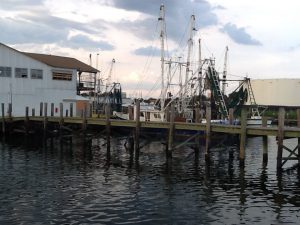
Commercial seafood in Pensacola has a long history.
Photo: Rick O’Connor
So what is local?
Well, we call any seafood product harvested or cultured within 250 miles local. For Pensacola, that would include Alabama, Mississippi, and eastern Louisiana. We know that between 80-90% of the seafood you currently purchase is imported from both commercial fishing and aquaculture overseas. That said, local seafood is still here and available.
The commercial fishing in Pensacola goes WAY back. It was one of the first industries to get off the ground shortly after Florida became a U.S. territory. According to Dr. Jack E. Davis, in his book The Gulf; The Making of an American Sea, Cuban fishermen harvested seafood from the Gulf coast of peninsula Florida prior to our becoming a territory. Shortly after becoming a U.S. territory, New England fishermen came to harvest the Gulf, including one by the name of Leonard Destin. Soon a fishing industry was operating in Pensacola. They sold a variety of species but in 1840 they found red snapper – and the boom was on. Shrimp followed but water quality, habitat loss, and overharvesting have plagued the industry over the years. Fishermen did well for a time, then the landings decreased, the fishermen believed the fish had moved, and so the fleet would move. This continued until they have literally moved all over the Gulf of Mexico seeking fish. At this point quotas had to be initiated and regulation has been the norm ever since. Add to this an increase interest in recreational fishing, increasing the number of fishermen, and increased regulation with this sector. Today we can include the introduction of invasive species as another stressor.
All that said, local seafood is still available. Some species have become quite pricey, but they are still available. The Gulf & South Atlantic Fisheries Foundation created a Gulf Coast Seafood Species Chart. This chart indicates when selected species are in peak season for commercial harvest. This chart suggests they are in season year round but there are peak months. It varies from one state to another, but the list below includes Florida and Alabama.
| Species |
Months in Peak Season |
Comments |
| Blue crab |
No peak season |
|
| Blue crab
Soft shell |
Mar – Jun |
|
| Black drum |
No peak season |
|
| Red drum |
No peak season |
Subject to quotas and closures |
| Clams |
All year – FL only |
Clams are now cultured in FL and are available year round |
| Crawfish |
Apr – Jun – LA only |
LA only, but close to us |
| Flounder |
Jul – Aug; Oct-Nov |
Subject to quotas and closures |
| Grouper |
No peak season |
Subject to quotas and closures |
| King mackerel |
Jan – Feb; Jul-Sep; Dec |
Subject to quotas and closures |
| Mahi-Mahi |
May – Jun |
|
| Mullet |
Jan; Sep – Dec |
|
| Oysters |
Jan – Apr; Sep – Dec |
|
| Pompano |
Jan – Apr; |
|
| Sheepshead |
No peak season |
|
| Brown shrimp |
May – Sep |
|
| Pink shrimp |
Jan – Jul |
|
| Rock shrimp |
Jun – Sep |
|
| White shrimp |
May – Nov |
|
| Snapper |
Peak season year round |
Subject to quotas and closures |
| Yellowtail snapper |
Mar – Jun |
|
| Spanish mackerel |
Jan – May; Aug – Sep; Dec |
Subject to quotas and closures |
| Spiny lobster |
Aug – Sep; Oct – Nov |
|
| Spotted seatrout |
No peak season |
Subject to quotas and closures |
| Stone crab |
Oct – Dec |
|
| Swordfish |
Sep – Nov |
|
| Yellowfin tuna |
Jun – Oct |
|
The health benefits from consuming seafood are understood. We certainly think it should be part of your of weekly dinner menu. There are concerns for safety in some seafood products, as in mercury and king mackerel, and we will address that in another article – but the lack of consuming seafood can create health issues as well. We hope you enjoy local Gulf seafood.
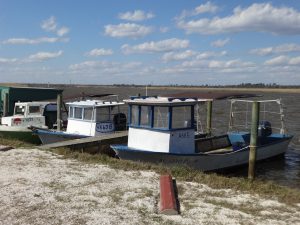
Commercial crab boats docked on Escambia Bay.
Photo: Rick O’Connor
References
Baker, G. 2017. personal communication.
Davis, J.E. 2017. The Gulf; Making of an American Sea. Liveright Publishing. New York NY. Pp. 530.
Gulf & South Atlantic Fisheries Foundation. 2013. Gulf Coast Seafood. www.eatgulfseafood.com
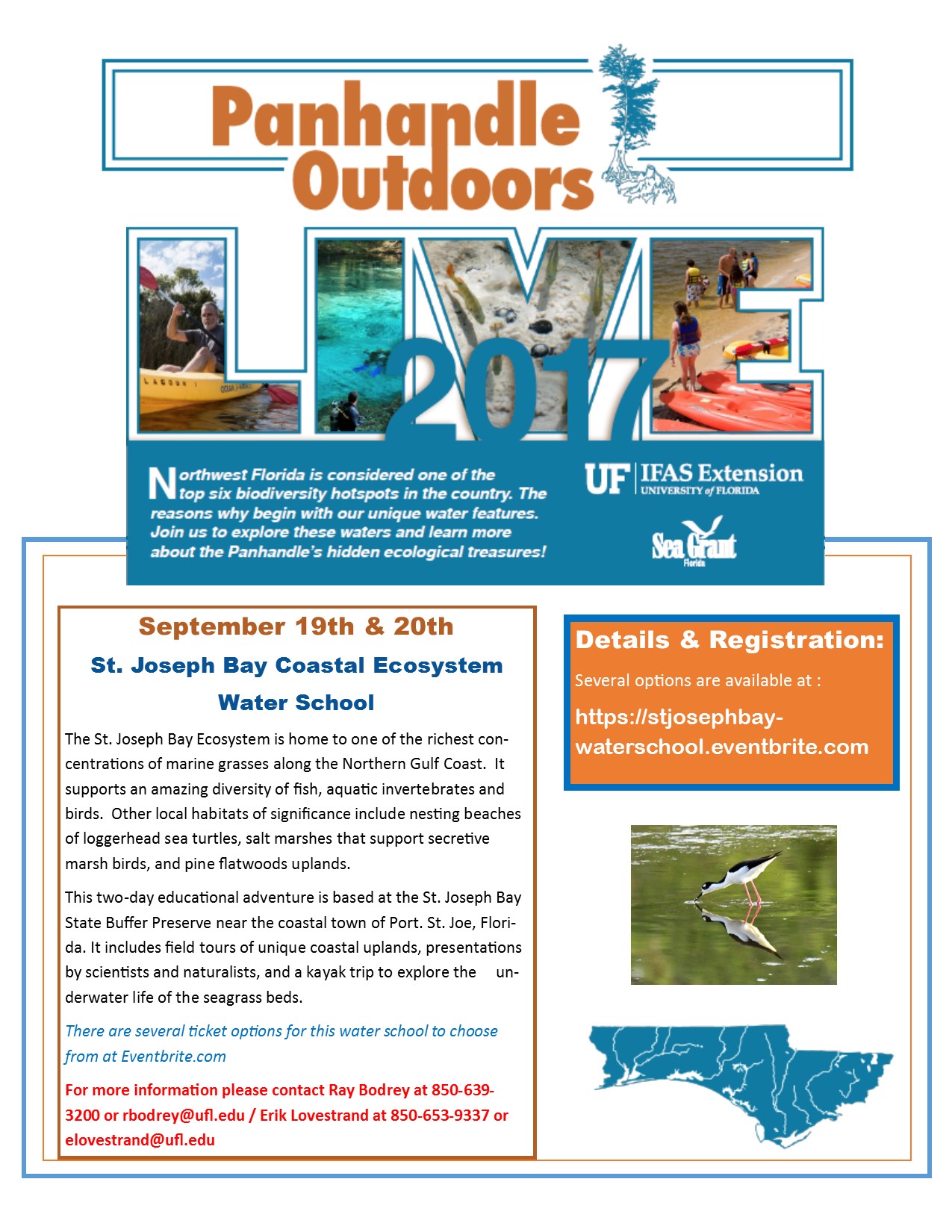
by Rick O'Connor | Aug 11, 2017
Our first POL program will happen this week – August 17 – at the Navarre Beach snorkel reef, and is sold out! We are glad you all are interested in these programs.
Well! We have another one for you. The Natural Resource Extension Agents from UF IFAS Extension will be holding a two-day water school at St. Joseph Bay. Participants will learn all about the coastal ecosystems surrounding St. Joe Bay in the classroom, snorkeling, and kayaking. Kayaks and overnight accommodations are available for those interested. This water school will be September 19-20. For more information contact Extension Agent Ray Bodrey in Gulf County or Erik Lovestrand in Franklin. Information and registration can be found at https://stjosephbay-waterschool.eventbrite.com.

by Rick O'Connor | Aug 11, 2017

A variety of plastics ends up in the Gulf. Each is a potential problem for marine life. Photo: Rick O’Connor
Since the early 1970’s, when Chief Iron Eyes Cody shed a tear on a television commercial, we have been trying to reduce the amount of solid waste found along our beaches and within our waters. Though numerous agencies and civic groups, led by the Ocean Conservancy, have held beach and underwater clean ups over the last few decades, the problem still exist.
However, we can say this – the problems have changed. Many groups collect data while they collect the debris to determine what, and how much, has been collected. This information can give folks an idea of what the major issues are. Because of this data, aluminum can pull-tabs and glass bottles are not as common as they once were. Communities saw they were a large problem and either removed them from the market or developed ordinances that banned them from beaches – this is certainly a success story. There are agencies and researchers who compile solid waste data to let people know what they are throwing away. Once we know this, we can be more effective at reducing marine debris.
Solid waste is not just a problem for coastal beaches; it is problem throughout society. Landfills will fill up, and communities will then need another location, or a new method, to dispose of it. Though the human growth rate has declined from 1.23% to 1.11% in the last decade, we are still growing and are currently at 7.5 billion humans on the planet. Each human will require resources to survive and, thus, will generate waste that will need to be disposed of. According to a paper published in 1990, humans were generating about 550 pounds of solid waste/person/year, which generated 1.3 billion tons of solid waste each year. In 2009 that increased to 2.3 billion tons.
So how much of this solid waste is being recycled?
According to the U.S. EPA, 258 million tons of municipal solid waste was generated in the United States in 2014. 89 million tons (34%) was recycled. This is an increase from the 30% reported in many environmental science textbooks 10 years ago and <20% 20 years ago. Some states are doing much better than the national average, Washington reports they are now recycling 51.4% of their solid waste, and some nations are recycling more than 90% – so things are improving but there is room for improvement.

Recycling trends in the United States.
Source: U.S. EPA
What is the situation in the Pensacola Bay area?
A non-profit organization called Ocean Hour cleans selected beaches for one hour every weekend. The team coordinates volunteers to help collect the debris by providing buckets, tongs, and gloves; they also dispose of the waste. Part of their mission is to provide data on what they are collecting so that the community is aware of what their largest problems are. Based on their data the top three items reported by volunteers for each year were:
| Year |
#1 Item |
#2 Item |
#3 Item |
| 2015
|
Cigarette butts |
Food wrappers |
Plastic bottles |
| 2016 |
Plastic bottles |
Aluminum cans |
Cigarette butts
Foam |
| 2017 (to date)
|
Cigarette butts |
Food wrappers |
Plastic and foam pieces |
The graph produced from Ocean Hour’s data by Escambia County Division of Marine Resource Intern Ethan Barker, shows all of the items they have collected this year but the bulk of it is associated with smoking and eating. Marine biologist and artist Shelly Marshall used 1200 cigarette butts collected by the Ocean Hour team to create a 3-foot sea turtle she calls CIG. She then used plastic bottles and plastic bottle caps, again collected by Ocean Hour, to create a 5-foot “bottle”nose dolphin called CAP. Both of these pieces of marine debris art are displayed at different locations in the community, and at community events, to educate the public about our marine debris problems.

Marine debris collected by Ocean Hour during the first half of 2017.
Image: Ethan Barker
So what do we do about it?
That is really up to us. Again, agencies, researchers, and non-profits have been reporting on the problem for almost five decades now. We will continue to produce waste, not much can be done there, but the question is what we will do with it. The obvious answer is dispose of properly and recycle when we can.
Cigarette Butts
- If you are a smoker, please dispose of your cigarette butt properly. There are “pocket ash trays” some folks use to keep the butt with them until they can find a place to dispose of it.
Food Wrappers – Foam
Much of the debris is related to eating – wrappers, plastic film, foam cups, straws, etc. Much of what we find is associated with this activity.
- You can use your own cup and not the foam cups provided by food establishments
- You can bring your own container to take leftovers home
- If you have to purchase food and drink with all of the wrappers and foam, and I understand that there are times you must, then do your best to dispose of properly.
Ocean Hour will continue their efforts to remove the debris from area beaches. If you can, volunteer to help now and then. You can find their schedule at https://www.oceanhourfl.com/.
If Ocean Hour is not conducting a clean up in your area, consider having your own. The Ocean Hour team can assist with the logistics of how to conduct one.
Again, we are not going to stop waste production – but maybe we can do better with waste disposal.
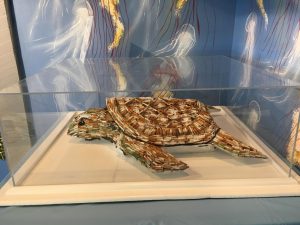
CIG is a sea turtle created by artist Shelly Marshall using 1200 cigarette butts collected by Ocean Hour in a 40 minute period on Pensacola Beach.
Photo: Cathy Holmes
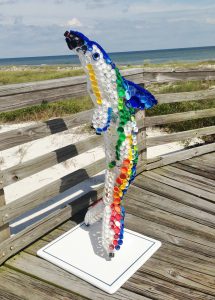
CAP is a 4-5′ bottlenose dolphin created by artist Shelly Marshall from plastic bottles and bottle caps collected by Ocean Hour on Pensacola Beach.
Photo: Shelly Marshall
Resources:
Advancing Sustainable Materials Management: Facts and Figures. 2017. U.S. Environmental Protection Agency. https://www.epa.gov/smm/advancing-sustainable-materials-management-facts-and-figures.
Al-Salem, S.M., P. Lettieri, J. Baeyens. 2009. Recycling and Recovery Routes of Plastic Solid Waste (PSW): A Review. Waste Management. Vol 29 (10). Pp. 2625-2643. http://www.sciencedirect.com/science/article/pii/S0956053X09002190.
Miller, G.T., S.E. Spoolman. 2011. Living in the Environment; Concepts, Connections, and Solutions. Brooks/Cole Publishing. Belmont CA. 16th edition. Pp. 674.
Solid Waste Recycling. 2016. Department of Ecology. State of Washington. http://www.ecy.wa.gov/beyondwaste/bwprog_swDiverted.html.
Sullivan, C. 2017. Human Population Growth Creeps Back Up. Scientific American. https://www.scientificamerican.com/article/human-population-growth-creeps-back-up/.
WorldoMeters. 2017. http://www.worldometers.info/world-population/.

by Rick O'Connor | Aug 11, 2017
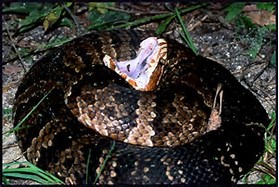
the “cottonmouth” gape of this venomous snakes is a warning. Notice the banded coloration of this individual.
Photo: UF IFAS Wildlife
Also known as the Water Moccasin, this is a snake that is all too familiar with most Floridians… Or is it? Several non-venomous water snakes are often confused with the cottonmouth and are thus killed. That said, cottonmouths are common in the state near areas of water and many residents do have encounters with them. This fact sheet will provide information that help reduce negative encounters with this venomous snake.
DESCRIPTION
- cottonmouths have a relatively thick-stout body with a broad head and thin neck
- they are generally banded and can be brown, gray, reddish in color; many become darker with age and may be solid black; cottonmouths who frequent tannic waters may have cooper color to them
- average length 36″ (3 ft.); max length 74″ (6 ft.)
JUVENILE DESCRIPTION
- copper colored with a yellowish-green tipped tail; used to attract prey
HOW TO TELL FROM NON-VENOMOUS WATER SNAKES
- there are several species of water snakes from the genus Neroidia which are confused with cottonmouths
- the scales between the eyes on top of the head are larger than others on the head; they have narrow necks
- Neroidia will have heads shaped more like your thumb and neck is as wide as head – NOTE: Neroidia CAN WIDEN THEIR HEAD WHEN THREATENED
- when head is viewed from above, the eyes of the cottonmouth are hard to see
- cottonmouths have a creamed colored cheek with dark “mask” extending from eye to back of lower jaw
- Neroidia may have creamed colored cheek but will lack “mask”; will possess thin vertical stripes that extend from lower to upper jaw
- there are single scales extending from the vent (anus) to tip of tail in cottonmouths; those same scales are divided into multiple ones on Neroidia
- the underside of the cottonmouth tail is usually dark; Neroidia is usually lighter in color
- pupil of cottonmouth is elliptical; it is round on Neroidia
- cottonmouths, being members of the pit viper family, will have heat sensing pit between nostril and eye; Neroidia will lack this pit
- scales are keeled, but this is true for some non-venomous snakes
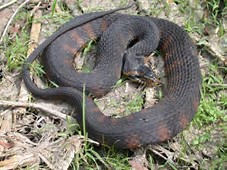
This banded water snake is often confused with the cottonmouth. This animal has the vertical stripes extending from the lower jaw, which is lacking in the cottonmouth.
Photo: University of Georgia
HOW TO TELL FROM OTHER PIT VIPERS
- cottonmouths are often confused with copperheads – both in same genus
- copperheads will lack characteristic “mask” found on cottonmouths and rattlesnakes
- the bands of the copperhead are more uniformed than the cottonmouth and are shaped like an hour glass
- copperheads are generally lighter in color
- it is difficult to tell young copperheads and cottonmouths apart; both have the light yellow-green tipped tail and light body coloring
SUBSPECIES OF COTTONMOUTHS
- there three recognized subspecies of cottonmouths
- the Florida Cottonmouth (Florida (A.p.conanti) – is darker, many times black, with two vertical bars on snout; found throughout the state of Florida
- the Eastern Cottonmouth (A. p. piscivorous) is lighter in color than the Florida and has no pattern on snout; found in extreme western Florida panhandle and the Appalachian valley of Alabama, Georgia, Tennessee, and North Carolina
- the Western Cottonmouth (A.p.leucostoma) – is similar to the eastern cottonmouth but darker in color; found in Mississippi, Louisiana, Texas, and Oklahoma
WHATS IN A NAME
- The Cottonmouth and the Water Moccasin are the two names for the same snake; herpetologist prefer to use the name Cottonmouth
- The snake was originally described by B.G.E. Lace (1789) using the term “piscivorous”; which means “fish eater”
- Gerard Troost (1836) describe the western subspecies using the term “leucostoma”; which means “white mouth”
- Howard Kay Gloyd (1969) described the Florida subspecies using the term “conanti”; which was honoring the herpetologist Roger Conant of the Philadelphia Zoo

Many in the panhandle use the terms cottonmouth and copperhead interchangeably. They are closely related but this photo of a copperhead shows the lighter coloration and the hour-glass shaped pattern of the blotches along the body.
Photo: UF IFAS Wildlife
BEHAVIOR
- cottonmouths are found throughout the southeast United States but avoid mountainous areas
- they are usually found with 30 feet of a water source, though some have been found as far as 100 feet away
- they prefer slow, quiet, backwater areas over faster flowing waterways
- they are most common in pine flatwoods but can be found in a variety of habitats and do well near humans
- they have been found in brackish water areas but freshwater is usually nearby
- they are becoming more common on barrier islands, and in some cases in high numbers, but do need sources of freshwater; they cannot extract from seawater
- cottonmouths hunt primarily at night; though daylight hunting happens
- on cool mornings they may climb lower branches of trees to bask; usually close to water
- they will remain still in one location for long periods of time waiting for prey to come within range; but they are known to stalk prey as well
- when prey are found they will strike using their hollow fangs to inject a hemotoxin; this venom is known to contain components that cause death, by attacking the muscle and circulatory system, and digestive enzymes to begin the process before swallowing
- in the cooler parts of their range cottonmouths will hibernate; but tend to be active year round in FL
PREY
- cottonmouths are carnivorous and opportunistic; prey include fish, small mammals, reptiles and birds; they will feed on smaller cottonmouths
- they are known to scavenge and are attracted to the smell of dead fish
- they hunt primarily at night but are known to during daylight hours as well
- they hunt fish and CAN bite underwater – despite the legend that they cannot
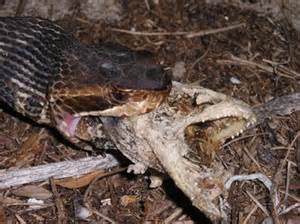
Cottonmouth’s are known to feed on a variety of prey including carrion.
Photo: University of Florida
PREDATORS
- primary predator include alligators, kingsnakes, and larger cottonmouths
- secondary predators include large mammals, birds, hawks, and owls
- cottonmouths tend to “freeze” when they first detect a predator – no movement at all
- if the predator gets too close they will vibrate their tail in leaf litter to alert the intruder and may gape their mouth showing the white inside of their “cottonmouth”; they may also flatten their bodies to appear bigger and release a musk as a warning
- they prefer to flee than bite but they will strike if they have nowhere to flee
REPRODUCTION
- mating occurs in spring and sometimes fall; in Florida they may mate year round
- males sense pheromones from females to know when it is time and, like other vipers, males may fight for the right to mate
- females can store sperm for long periods of time and typically breed every other year
- females give live birth in late summer to early fall; they sometimes congregate to give birth
- the average number of offspring/litter is 7-12 but can be as high as 22
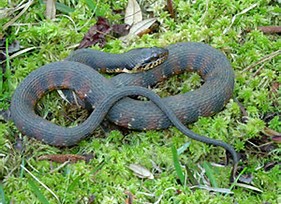
Is this a cottonmouth?
No, it is not…
Can you tell why?
Photo: University of Florida
DEALING WITH ENCOUNTERS
KEEPING THEM AT A DISTANCE
- when hiking in cottonmouth territory it is recommended to wear high boots and look down while walking; if you need to look ahead we recommend you stop walking – look ahead – and then put your eyes back to the ground while walking
- stay on trails; snakes do not like short grass; avoid walking in tall grass where they may be hiding
- to keep cottonmouths away from your home – reduce food sources, freshwater sources, and shelter areas
- cottonmouths like fish ponds and are often found in the filter system; they may be attracted to swimming pools
- cottonmouths also eat rodents; bird feeders, sacks of corn, wood and brush pikes can attract cottonmouth prey, and thus cottonmouths
- if you must have brush piles and bird feeders place them away areas where people frequent – away from front and back doors, sidewalks, etc.
- many properties have natural ponds and swimming pools; if encounters are a problem consider placing some small mesh fencing to keep them from reaching the source may be helpful; this fencing should be buried 2-6″ below the surface and the wooden stakes should be on your side of the fence – snakes can climb the rough wood stakes; if you cannot continue the fencing across your entire property – make a 90° turn AWAY from your property to encourage them to return from where they came
IF I ENCOUNTER ONE
- despite stories, cottonmouths do not chase people; most will sit very still hoping you do not see them; I have personally accidentally placed my foot within inches of a cottonmouths with no reaction from the snakes; their first reaction is to “freeze”
- if they feel you are getting too close they often will begin to vibrate their tail very fast; this means they are getting nervous and are warning you to stay clear; many times they are in leaf litter when they do this and you can hear them – DO NOT APPROACH ANY CLOSER; the probability of a strike is still low, but has increased
- another warning behavior is mouth gaping and showing of white mouth- “cottonmouth”; though strike probability is still low, studies show that gaping cottonmouths tend to strike more often than tail vibrating ones – DO NOT APPROACH; move back and allow the snake to pass

The dark phase of the cottonmouth. This is an older individual.
Photo: UF IFAS
BUT WHAT IF I ALLOW IT TO PASS AND IT IS HEADING FURTHER ON TO MY PROPERTY?
- great news right?
- statistics show that about 95% of people bitten by snakes are trying to catch it or kill it – so trying to remove it yourself significantly increases your chance of getting bit
- many have had success with sweeping non-venomous snakes into a trash can with a broom and releasing somewhere… But these are non-venomous snakes, we recommend professionals for venomous snake removal
- you may have no other optional than to kill the snake; if this is the case be careful… Again, many are bitten trying to kill snakes; also know that snakes are known to strike after they are a dead
WHAT IF I AM BITTEN?
- first know that death from cottonmouths is very rare; annually in the U.S. about 7,000 – 8,000 people are bitten by venomous snakes (about 1 in 40,000 people) and about 5-6 die (about 1 in 50 million)
- also know that many times vipers give what is called a “dry bite” – no venom injected; but you do not know this so treat as if venom was injected; MANY WHO DIE FROM VENOMOUS SNAKE BITES DID NOT SEEK MEDICAL ATTENTION
- first rule is DO NOT GET BIT TWICE; after being bit many people will then try to kill the snake and are bitten again; many feel that they need the snake at the hospital for identification – they do not
- second rule is to remain calm; easier said than done, but an elevated heart rate will move the toxin within the blood faster
- with toxic viper bites there will be pain and swelling; remove watches, jewelry, or any tight fitting clothing from bite area
- you do not need to add ice or heat
- we do not recommend tourniquets, lancing the bite and sucking out venom; many times the venom has spread from the bite area and health officials have found that many times there are more problems with the “first aid” than with the bite itself
- try not to move the limb where bite occurred- easier said than done; if you can elevate your heart above the bite this is good
- do not drink alcohol; you may think you need a drink right now but you do not; alcohol or caffeine can accelerate heart and spread venom faster
- call 911 and alert the closest hospital that you have a snake bite victim coming in; answer any questions they may have to the best of your ability
- again, do your best to relax and get to a hospital; fatalities are rare due to the excellent medical care in this country
All of this said, there is a lot of concern surrounding cottonmouths in Florida. As we expand our neighborhoods into more of their habitat, we will encounter more of them. In some cases, the location for their resources may be our neighborhoods. We will need to learn how to identify them and understand their behavior to avoid negative encounters. The statistics show that they are not as big a threat as they are perceived to be, but folks are still concerned for their family and pets – and understandably so. Hopefully information in this fact sheet will be of help to you.
REFERENCES
Ashton, R.E., P.S. Ashton. 1981. Handbook of Reptiles and Amphibians of Florida; Part I Snakes. Windward Publishing. Miami FL. pp. 175.
Gibbons, W., M. Dorcas. 2005. Snakes of the Southeast. University of Georgia Press. Athens, GA. Pp. 253.
Gibbons, W. 2017. Snakes of the Eastern U.S. University of Georgia. Athens GA. pp. 416.
http://www.bioone.org/doi/abs/10.2994/1808-9798(2008)3%5B175:TEOICS%5D2.0.CO%3B2
http://www.bioone.org/doi/abs/10.1643/CH-04-243R1?journalCode=cope
https://academic.oup.com/bioscience/article/58/10/947/245888/Pitviper-Scavenging-at-the-Intertidal-Zone-An
http://escholarship.org/uc/item/9j69w675
http://ufdc.ufl.edu/files/UFE0046057/00001/WIXSON_J.pdf
http://www.herpconbio.org/Volume_10/Issue_2/Hanson_McElroy_2015.pdf
http://onlinelibrary.wiley.com/doi/10.1111/j.1365-2699.2008.02075.x/full
http://www.bioone.org/doi/abs/10.1643/0045-8511(2002)002%5B0195:DBOCAP%5D2.0.CO%3B2
https://academic.oup.com/beheco/article/15/2/365/223992/Size-based-variation-in-antipredator-behavior
http://www.jstor.org/stable/3890390?seq=1#page_scan_tab_contents
https://www.floridamuseum.ufl.edu/herpetology/fl-snakes/list/agkistrodon-piscivorus-piscivorus/
http://ufwildlife.ifas.ufl.edu/pdfs/cottonmouth.pdf
Johnson, S.A. Frequently Asked Questions About Venomous Snakes. http://ufwildlife.ifas.ufl.edu/venomous_snake_faqs.shtml.
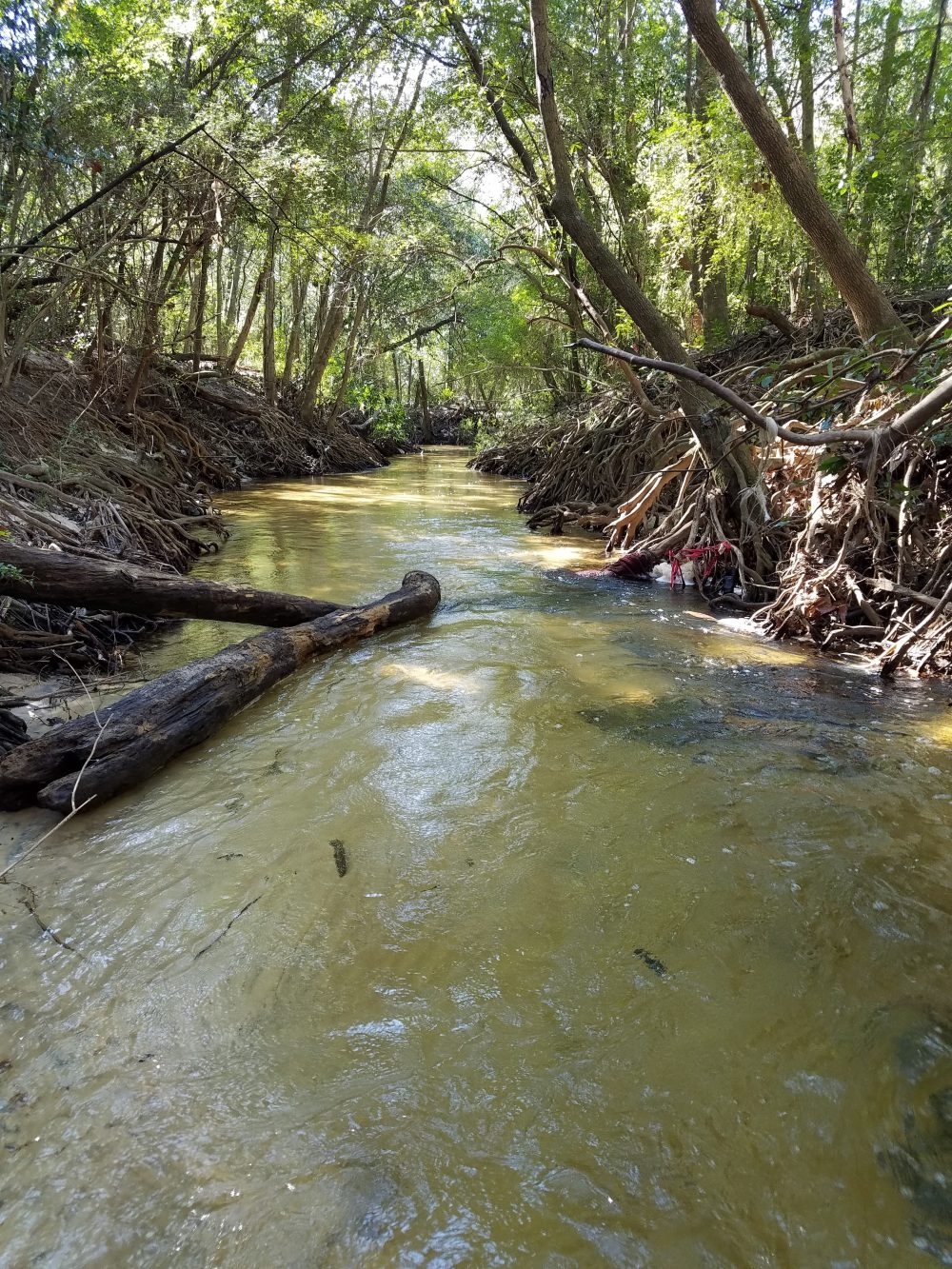
by Rick O'Connor | Jul 29, 2017
ARTICLE BY DR. MATT DEITCH; water quality specialist – University of Florida Milton
Summer is a great time for weather-watching in the Florida panhandle. Powerful thunderstorms appear out of nowhere, and can pour inches of rain in an area in a single afternoon. Our bridges, bluffs, and coastline allow us to watch them develop from a distance. Yet as they come closer, it is important to recognize the potential danger they pose—lightning from these storms can strike anywhere nearby, and can cause fatality for a person who is struck. Nine people were killed by lightning strike in Florida in 2016 alone, more than in any other state. Because of the risk posed by lightning, my family and I enjoy these storms up-close from indoors.
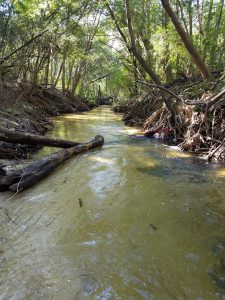
Carpenter’s Creek in Pensacola
Photo: Dr. Matt Deitch
A fraction of the rain that falls during these storms is delivered to our bays, bayous, and estuaries through a drainage network of creeks and rivers. This streamflow serves several important ecological functions, including preventing vegetation encroachment and maintaining habitat features for fish and amphibians through scouring the streambed. High flows also deposit fine sediment on the floodplain, helping to replenish nutrients to floodplain soil. On average, only about one-third of the water that falls as rain (on average, more than 60 inches per year!) turns into streamflow. The rest may either infiltrate soil and percolate into groundwater; or be consumed and transpired by plants; or evaporate off vegetation, from the soil, or the ground surface before reaching the soil. Evaporation and transpiration play an especially large role in the water cycle during summer: on average, most of the rain that falls in the Panhandle occurs during summer, but most stream discharge occurs during winter.
The water that flows in streams carries with it many substances that accumulate in the landscape. These substances—which include pollutants we commonly think of, such as excessive nutrients comprised of nitrogen and phosphorus, as well as silt, oil, grease, bacteria, and trash—are especially abundant when streamflow is high, typically during and following storm events. Oil, grease, bacteria, and trash are especially common in urban areas. The United States EPA and Florida Department of Environmental Protection have listed parts of the Choctawhatchee, St. Andrew, Perdido, and Pensacola Bays as impaired for nutrients and coliform bacteria. Pollution issues are not exclusive to the Panhandle: some states (such as Maryland and California) have even developed regulatory guidelines in streams (TMDLs) for trash!
Many local and grassroots organizations are taking the lead on efforts to reduce pollution. Some municipalities have recently publicized efforts to enforce laws on picking up pet waste, which is considered a potential source of coliform bacteria in some places. Some conservation groups in the panhandle organize stream debris pick-up days from local streams, and others organize volunteer citizens to monitor water quality in streams and the bays where they discharge. Together, these efforts can help to keep track of pollution levels, demonstrate whether restoration efforts have improved water quality, and maintain healthy beaches and waterways we rely on and value in the Florida Panhandle.
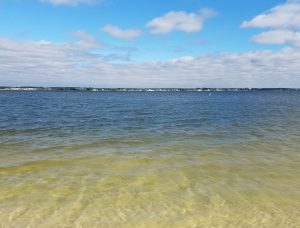
Santa Rosa Sound
Photo: Dr. Matt Deitch



















